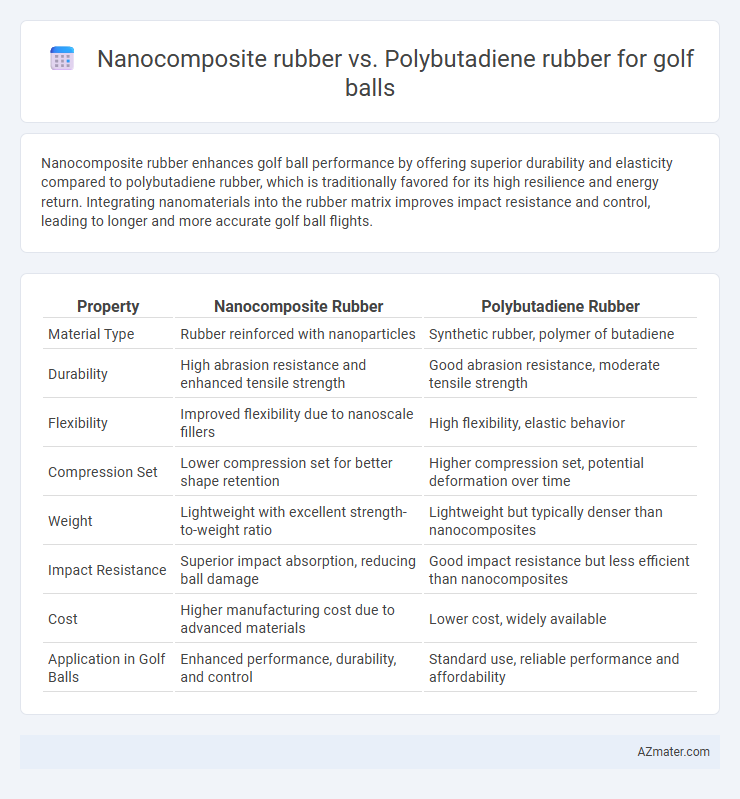Nanocomposite rubber enhances golf ball performance by offering superior durability and elasticity compared to polybutadiene rubber, which is traditionally favored for its high resilience and energy return. Integrating nanomaterials into the rubber matrix improves impact resistance and control, leading to longer and more accurate golf ball flights.
Table of Comparison
| Property | Nanocomposite Rubber | Polybutadiene Rubber |
|---|---|---|
| Material Type | Rubber reinforced with nanoparticles | Synthetic rubber, polymer of butadiene |
| Durability | High abrasion resistance and enhanced tensile strength | Good abrasion resistance, moderate tensile strength |
| Flexibility | Improved flexibility due to nanoscale fillers | High flexibility, elastic behavior |
| Compression Set | Lower compression set for better shape retention | Higher compression set, potential deformation over time |
| Weight | Lightweight with excellent strength-to-weight ratio | Lightweight but typically denser than nanocomposites |
| Impact Resistance | Superior impact absorption, reducing ball damage | Good impact resistance but less efficient than nanocomposites |
| Cost | Higher manufacturing cost due to advanced materials | Lower cost, widely available |
| Application in Golf Balls | Enhanced performance, durability, and control | Standard use, reliable performance and affordability |
Introduction to Golf Ball Materials
Nanocomposite rubber enhances golf ball performance by integrating nanoscale fillers into the polymer matrix, improving durability and resilience compared to traditional polybutadiene rubber. Polybutadiene rubber, widely used in golf ball cores, offers excellent elasticity and energy return but may lack the advanced mechanical strength provided by nanocomposites. The incorporation of nanomaterials into rubber formulations creates golf balls with optimized compression, spin control, and distance.
Overview of Nanocomposite Rubber Technology
Nanocomposite rubber integrates nanoscale fillers such as silica or clay into a polymer matrix, significantly enhancing mechanical properties and durability compared to traditional polybutadiene rubber. This technology improves abrasion resistance, tensile strength, and energy return, making it highly advantageous for golf balls seeking enhanced performance and longevity. The nanoscale dispersion within the rubber matrix optimizes the interfacial interaction, resulting in superior material stiffness and resilience critical for advanced golf ball construction.
Understanding Polybutadiene Rubber Properties
Polybutadiene rubber, known for its high resilience and excellent abrasion resistance, plays a crucial role in golf ball core formulations, enhancing energy restitution and distance. Its low glass transition temperature ensures superior elasticity at varying temperatures, providing consistent performance during play. In contrast, nanocomposite rubber integrates nanoparticles to improve tensile strength and durability, but polybutadiene remains the preferred base rubber for achieving optimal balance between hardness and elasticity in golf ball design.
Comparative Analysis: Elasticity and Resilience
Nanocomposite rubber exhibits superior elasticity and resilience compared to polybutadiene rubber, enhancing golf ball performance by providing greater energy return and improved distance. The incorporation of nanoscale fillers in nanocomposite rubber reinforces its molecular structure, resulting in higher tensile strength and better deformation recovery. Polybutadiene rubber, while commonly used for its good resilience and cost-effectiveness, lacks the enhanced durability and long-term elasticity found in nanocomposite variants, making the latter more suitable for high-performance golf balls.
Performance Impact on Ball Speed and Distance
Nanocomposite rubber enhances golf ball performance by improving material stiffness and energy transfer, resulting in higher ball speed and increased distance compared to traditional polybutadiene rubber. The incorporation of nanoparticles optimizes the rubber matrix, reducing energy loss during impact and promoting more efficient rebound characteristics. Polybutadiene rubber, while offering good resilience and durability, typically delivers lower ball speed and shorter distance due to less advanced molecular reinforcement.
Durability and Wear Resistance Factors
Nanocomposite rubber incorporates nanoscale fillers that significantly enhance the durability and wear resistance of golf balls compared to traditional polybutadiene rubber. The presence of silica nanoparticles in nanocomposite rubber improves tensile strength and abrasion resistance, reducing deformation and surface wear during repeated impacts. Polybutadiene rubber, while offering good resilience and elasticity, typically exhibits lower wear resistance and can degrade faster under high-stress playing conditions.
Influence on Spin and Control
Nanocomposite rubber enhances golf ball performance by providing superior spin control and increased surface friction compared to traditional polybutadiene rubber. The integration of nanoparticles in the rubber matrix improves energy transfer and resilience, resulting in tighter spin radius and enhanced shot precision. Polybutadiene rubber, while offering good durability and distance, lacks the optimized spin responsiveness offered by nanocomposite formulations, making nanocomposites the preferred choice for improved greenside control.
Cost Efficiency and Production Scalability
Nanocomposite rubber offers improved cost efficiency in golf ball manufacturing due to enhanced material properties that reduce the amount of rubber needed without compromising performance, lowering raw material expenses compared to polybutadiene rubber. Production scalability is advantaged by nanocomposite formulations that integrate seamlessly into existing mixing and molding processes, enabling faster production rates and consistent quality at large volumes. Polybutadiene rubber, while widely used for its durability and resilience, faces limitations in cost reduction and process adaptability when scaled, making nanocomposite rubber a more economically viable alternative for high-volume golf ball production.
Environmental Implications and Sustainability
Nanocomposite rubber enhances golf ball performance while offering improved environmental sustainability through reduced resource consumption and increased durability compared to polybutadiene rubber. Polybutadiene rubber, derived from petrochemical processes, has a higher carbon footprint due to its energy-intensive production and limited recyclability. Nanocomposite rubber's integration of nanomaterials enables longer-lasting golf balls, minimizing waste and promoting eco-friendly manufacturing practices.
Future Trends in Golf Ball Material Innovation
Nanocomposite rubber in golf balls offers enhanced mechanical properties and durability compared to traditional polybutadiene rubber, driving innovation toward higher performance and longer-lasting golf balls. Advances in nanotechnology enable fine tuning of material stiffness and impact resilience, which contribute to improved energy transfer and distance. Emerging trends indicate increasing adoption of nanocomposite formulations to meet demands for optimized spin control and environmental sustainability in golf ball manufacturing.

Infographic: Nanocomposite rubber vs Polybutadiene rubber for Golf ball
 azmater.com
azmater.com